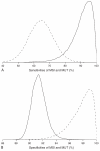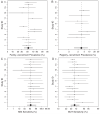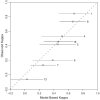Random Effects Models in a Meta-Analysis of the Accuracy of Two Diagnostic Tests Without a Gold Standard
- PMID: 19562044
- PMCID: PMC2701906
- DOI: 10.1198/jasa.2009.0017
Random Effects Models in a Meta-Analysis of the Accuracy of Two Diagnostic Tests Without a Gold Standard
Abstract
In studies of the accuracy of diagnostic tests, it is common that both the diagnostic test itself and the reference test are imperfect. This is the case for the microsatellite instability test, which is routinely used as a prescreening procedure to identify individuals with Lynch syndrome, the most common hereditary colorectal cancer syndrome. The microsatellite instability test is known to have imperfect sensitivity and specificity. Meanwhile, the reference test, mutation analysis, is also imperfect. We evaluate this test via a random effects meta-analysis of 17 studies. Study-specific random effects account for between-study heterogeneity in mutation prevalence, test sensitivities and specificities under a nonlinear mixed effects model and a Bayesian hierarchical model. Using model selection techniques, we explore a range of random effects models to identify a best-fitting model. We also evaluate sensitivity to the conditional independence assumption between the microsatellite instability test and the mutation analysis by allowing for correlation between them. Finally, we use simulations to illustrate the importance of including appropriate random effects and the impact of overfitting, underfitting, and misfitting on model performance. Our approach can be used to estimate the accuracy of two imperfect diagnostic tests from a meta-analysis of multiple studies or a multicenter study when the prevalence of disease, test sensitivities and/or specificities may be heterogeneous among studies or centers.
Figures



References
-
- Albert PS, McShane LM, Shih JH. Latent Class Modeling Approaches for Assessing Diagnostic Error without a Gold Standard: with Applications to P53 Immunohistochemical Assays in Bladder Tumors. Biometrics. 2001;57:610–619. - PubMed
-
- Albert PS, Dodd LE. A Cautionary Note on the Robustness of Latent Class Models for Estimating Diagnostic Error without a Gold Standard. Biometrics. 2004;60:427–435. - PubMed
-
- Andersen S. Re: Bayesian Estimation of Disease Prevalence and the Parameters of Diagnostic Tests in the Absence of a Gold Standard. American Journal of Epidemiology. 1997;145:290–291. - PubMed
-
- Boland CR, Thibodeau SN, Hamilton SR, Sidransky D, Eshleman JR, Burt RW, Meltzer SJ, Rodriguez-Bigas MA, Fodde R, Ranzani GN, Srivastava S. A National Cancer Institute Workshop on Microsatellite Instability for Cancer Detection and Familial Predisposition: Development of International Criteria for the Determination of Microsatellite Instability in Colorectal Cancer. Cancer Research. 1998;58:5248–5257. - PubMed
Publication types
Grants and funding
LinkOut - more resources
Full Text Sources
